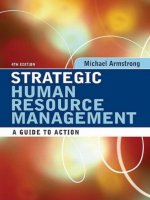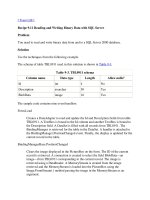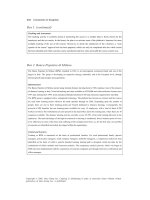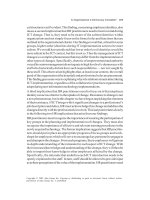Tài liệu Strategic Human Resources Management: Aligning with the Mission doc
Bạn đang xem bản rút gọn của tài liệu. Xem và tải ngay bản đầy đủ của tài liệu tại đây (119.68 KB, 42 trang )
U.S. Office of Personnel Management
Office of Merit Systems Oversight and Effectiveness
Strategic Human Resources Management:
Aligning with the Mission
September 1999
This page intentionally left blank.
STRATEGIC HUMAN RESOURCES MANAGEMENT:
ALIGNING WITH THE MISSION
Contents
Executive Summary .......................................................... i
I. Introduction ............................................................1
What is Alignment? ....................................................1
Why Align? ..........................................................1
The Study ...........................................................3
II. Strategic Planning ........................................................5
Agencywide Planning ...................................................5
HRM Integration in Agency Strategic Plans ..................................7
Agency HRM Strategic Measures .........................................8
HR Involvement in Agency Strategic Planning ................................9
Agency Annual Performance Plans ........................................11
HR Strategic Plans ....................................................12
III. Strategic Implementation .................................................15
Strategic HRM Activities ...............................................15
HRM Measurement ...................................................18
IV. Strategic Relationships ..................................................21
Corporate HR and Top Agency Management ................................21
The HR Office and Line Management .....................................23
Accountability .......................................................24
V. Where Do We Go From Here? .............................................25
Conclusion ..........................................................26
Appendix A - Non-Federal Findings ............................................A-1
Private Sector ......................................................A-1
Non-Federal Public Sector .............................................A-2
Appendix B - HRM Alignment Bibliography .....................................B-1
Internet Sites .......................................................B-5
This page intentionally left blank.
U.S. Office of Personnel Management Page i
EXECUTIVE SUMMARY
Human resources alignment means integrating decisions about people with decisions about the
results an organization is trying to obtain. By integrating human resources management (HRM)
into the agency planning process, emphasizing human resources (HR) activities that support broad
agency mission goals, and building a strong relationship between HR and management, agencies
are able to ensure that the management of human resources contributes to mission
accomplishment and that managers are held accountable for their HRM decisions. This is
especially important in light of the Government Performance and Results Act’s (GPRA) push to
align all agency activities, including HRM, toward achieving defined agency strategic goals and
measuring progress toward those goals.
In fiscal year 1999, the U.S. Office of Personnel Management (OPM) embarked on a special study
to determine how much progress Federal agencies have made toward aligning HRM with agency
strategic goals in support of HRM accountability and agency mission accomplishment. Our key
findings and conclusions are summarized as follows.
C Many more agencies than expected include HR representatives in the agency planning process
and integrate human resources management goals, objectives, and strategies into agency
strategic plans. However, most agencies are still struggling in this area. Therefore, agency
executives and HR leaders need to work together to fully integrate HRM into the planning
process so that it will become a fundamental, contributing factor to agency planning and
success.
C Although some agency HR offices have begun focusing on organizational activities that assist
agency decision-making, most are still emphasizing internal HR office efficiency efforts. While
internal issues are important to the success of any HR program, HR offices also need to
examine the “big picture” and find ways to impact the success of the agency as a whole.
C Most agencies are in some way measuring the efficiency and/or effectiveness of the HR
function. These measures, however, are generally output-oriented, focus on internal HR
processes and activities, and are used to make improvements to HR-specific policies and
procedures. As HR refocuses its activities to broader organizational issues, HRM measures
also need to be expanded to gauge the impact HRM has on agency goals and mission. Then,
the measurement data can be used to inform agency-level decisions.
Executive Summary
U.S. Office of Personnel ManagementPage ii
C The relationship between HR and management is becoming more collaborative. HR executives
are beginning to earn a seat at the management table. HR offices are becoming more
consultative and involved in day-to-day line management activities. Nevertheless, there is still
a long way to go if HR is to become a strategic partner at all levels. To do so, HR needs to
build its own internal competencies to deal with organizational issues, educate itself on agency
and program missions, and find ways to offer creative and innovative solutions to
organizationwide issues.
Although many National Performance Review (now known as the National Partnership for
Reinventing Government) initiatives, such as downsizing, reorganizing, streamlining, and
delegating HR authorities, were meant to improve HR’s ability to focus on organizational issues,
they have not taken hold as quickly or thoroughly as hoped. Therefore, HR is still doing most of
the process work, and its ability to focus on alignment has been limited. However, as HR’s role in
agency planning, activities, and decision-making advances -- and it is advancing -- so too will the
alignment of human resources management with agency mission accomplishment.
Legal Compliance
Efficient HR Processes
Effective HRM Programs
Alignment
with Strategic
Goals of the
Organization
For consistency’s sake, this report uses the term “agency” when referring to the broadest form of the Federal
1
organization. For instance, the Department of Agriculture, along with all its components, is an “agency.” When
addressing specific components within an agency, the report will refer to them as “sub-components.”
U.S. Office of Personnel Management Page 1
I. INTRODUCTION
Hierarchy of Accountability
A company is known by the people it keeps.
- Unknown
What is Alignment?
Strategic human resources management...strategic alignment...alignment with mission accom-
plishment. These are just a few of the terms being used to describe the new, evolving role of
Federal human resources management (HRM). What do these terms really mean? If you were to
ask agency personnelists, managers, or employees, you would probably get a wide range of
answers. So, it’s important to establish from the beginning what we are really talking about.
Human resources management alignment means to integrate decisions about people with
decisions about the results an organization is trying to obtain. Our research indicates that
agencies that successfully align human resources management with agency mission
accomplishment do so by integrating HRM into the agency planning process, emphasizing HR
activities that support mission goals, and building strong HR/management relationships.
1
In addition to being a vital contributor to
agency mission accomplishment, HRM
alignment is the ultimate level of HRM
accountability, as demonstrated in the
Hierarchy of Accountability. While HRM
accountability must begin with basic legal
compliance, it ultimately encompasses all four
levels of the pyramid, including demonstrating
how HRM supports achievement of the
agency strategic goals.
Why Align?
Why the sudden emphasis on aligning HRM activities with agency mission accomplishment?
Basically, it comes down to demonstrating the value of human resources management to the
Introduction
Now known as the National Partnership for Reinventing Government.
2
U.S. General Accounting Office. Major Management Challenges and Program Risks: A Governmentwide
3
Perspective.
U.S. Office of Personnel ManagementPage 2
agency. In the past, one of HR’s primary roles has been to ensure compliance with laws, rules,
and regulations. Although this is still, and will always be, a necessary function, many recent
developments have led to a strong emphasis on results.
The National Performance Review (NPR) took on the task of reinventing government to make it
2
work better, cost less, and get results. NPR mandated many initiatives that changed the focus of
HR from just compliance toward results, including downsizing the HR function, delegating HR
authorities to line managers, calling for HR to demonstrate its business value, and enhancing
customer service. Through these initiatives, management of human resources would become
more responsive to mission-related needs because it would take place at the line level, and the HR
staff would be able to expend more of its energy on broader organizational issues.
The Government Performance and Results Act (GPRA) of 1993 has also played a large part in
focusing agencies on results. The purpose of GPRA is to improve Federal program effective-
ness, accountability, service delivery, decision-making, and internal management, thereby
improving confidence in the Federal Government. This is achieved by demonstrating organiza-
tional results through strategic planning and performance measures. Although the primary focus
of GPRA is on programmatic functions, agencies are also required to describe how administra-
tive resources, such as HR, are being used to achieve strategic goals. Further, the General
Accounting Office (GAO) and the Office of Management and Budget (OMB) have evaluated
many of these efforts, and are calling for agencies to improve their discussions of HRM alignment
in strategic and annual plans. Therefore, the human resources function is increasingly being
aligned to the agency strategic plan, which requires HR to show how it is supporting mission
accomplishment.
Alignment has already occurred in other key administrative functions. When Congress devel-oped
a statutory framework to introduce performance-based management into the Federal Government,
it initiated financial, information technology, and procurement reforms through such mandates as
the Chief Financial Officer Act and Information Technology Management Reform Act. Human
resources management is the administrative missing link to this comprehensive package.
3
The private sector has recognized that it is not just financial and technological capital that provide
companies with the competitive edge, but people, or human capital. Without attracting and
retaining the right people, in the right jobs, with the right skills and training, an organization
cannot succeed. Therefore, people have been recognized as companies’ most important asset. As
the Federal Government moves toward a performance-based management approach, we, too,
need to realize the importance of our human resources. A huge percentage of agencies’ budgets
Introduction
U.S. Office of Personnel Management Page 3
is spent on human resources -- salaries, benefits, training, work life programs, etc. Nowhere else
do you make that substantial an investment and not measure the return.
Not only do human resources provide the competitive edge, but several recent studies have
confirmed that the quality and innovation of HR practices impact business results. These studies
were able to draw a correlation between increased quality of HR practices and increased business
success. Among other benefits, HR alignment with mission accomplishment increases HR’s
ability to anticipate its customers’ needs, increases the agency’s ability to implement strategic
business goals, and provides decision-makers with critical resource allocation information.
Finally, HR alignment is a vital process to advance agency accountability. By defining, main-
taining, and assessing HRM goals and measures, communicating them throughout the agency, and
using the information to make management decisions, agencies are able to ensure that the
management of human resources contributes to mission accomplishment and that managers are
held accountable for their HRM decisions in support of mission accomplishment.
The Study
Once we defined what alignment means and why it is important, we wanted to find out where
agencies currently stand in terms of aligning their human resources management with agency
mission accomplishment. Therefore, the Office of Personnel Management (OPM) embarked on a
special study designed to explore the following objectives:
< Assess how well human resources management is linked to agency mission
accomplishment;
< Explore the role played by the HR staff in agency strategic planning;
< Determine how the HR service providers work with line managers to carry out agency
strategic goals; and
< Identify best practices aligning HRM with the agency strategic plan and goals.
In order to obtain information pertaining to these objectives, we did the following:
< Reviewed 31 agency strategic and 28 annual performance plans;
< Conducted an extensive literature and Internet search;
< Gathered information from agency HR professionals, supervisors, and employees at 17
agencies of various size through the fiscal year 1998 and 1999 OPM Oversight reviews;
Introduction
U.S. Office of Personnel ManagementPage 4
and
< Interviewed nine additional leading agency HR Directors.
GPRA Strategic Planning Process - Simplified
Performance
Reports
Status report on
achievement of agency
goals
Performance
Reports
Status report on
achievement of agency
goals
Annual
Performance Plan
Operational level
strategies, measures,
and timeframes to support
strategic goals
Annual
Performance Plan
Operational level
strategies, measures,
and timeframes to support
strategic goals
Strategic Plan
High level agency goals,
strategies, and needed
resources
Strategic Plan
High level agency goals,
strategies, and needed
resources
U.S. Office of Personnel Management Page 5
II. STRATEGIC PLANNING
You got to be careful if you don't know where you're going, because you might not get there.
- Yogi Berra
Agencywide Planning
To some agencies, strategic planning is a way of life. To others, it’s an exercise. To almost all,
it’s a requirement. As part of GPRA, agencies, unless specifically exempted, follow a continuous,
three step strategic planning process:
Strategic planning allows agencies to map out where they are, where they want to go, and how
they plan to get there. Some agencies adopted the idea of strategic planning even before GPRA
was enacted, whereas others are just beginning to understand its potential benefits. The results of
the fiscal year 1999 Merit System Principles Questionnaire (MSPQ), an OPM Governmentwide
survey of supervisors and employees, show that agencies are beginning to embrace not only the
concept, but also the practice, of strategic planning.
Agency Head
Sets strategic
direction within
defined mission
Planning Office
Coordinates tracking
of agency goals and
measures
Top Management
Develops top level
goals, strategies,
measures
Line
Develops programmatic
implementation plans
Employees and
Stakeholders
Provide input
Typical Agency Planning Process
Strategic Planning
U.S. Office of Personnel ManagementPage 6
MSPQ Results
C 62% agree that their agency has a process for developing strategic, long-range plans
and updating them periodically.
C 65% agree that operational goals and objectives are set to help the agency meet
strategic, long-range plans.
C 54% agree that progress toward goals is measured.
C 61% agree that information is collected for assessing performance.
The strategic planning process varies from agency to agency. On one end of the spectrum are the
agencies which have very collaborative processes involving senior management, line supervisors
and employees, and stakeholders throughout the entire process. On the other end are the agen-
cies which develop plans at the top management level with little input from the line or stake-
holders or that plan functionally, having each program office submit its own goals and strategies
with little to no collaboration among offices. The typical strategic planning process is a mixture
of these:
HRM Integration in Agency Strategic Plans
Strategic Planning
U.S. Office of Personnel Management Page 7
The management of agency human resources is an integral part of how an agency is going to
achieve its mission goals. Without people, there is no one to do the work. Therefore, integrating
HRM into the agency strategic plan is the first step in aligning it with the mission.
Even though GAO and OMB are pushing for improvement of HRM alignment discussions in
strategic and annual plans, GPRA’s primary focus is still on agency programs, rather than
corporate functions. Therefore, we assumed at the beginning of this study that not many agency
strategic plans would have addressed HRM’s role in mission accomplishment. We were
pleasantly surprised. Out of the 31 strategic plans reviewed, 87 percent had addressed HRM in
some way. Below is a breakdown of how integration between HRM and the agency plan is
achieved, a count of how many strategic plans have integrated HRM in a particular way, and
some examples of actual agency approaches.
How used: # of plans: Examples:
Mission Goals 8
(Listed side-by-side
with program goals)
Social Security Administration’s Mission Goal: To be an employer
that values and invests in each employee.
Air Force’s Mission Goal: Ensure a high quality force of dedicated
professionals and provide an enhanced quality of life and strong sense of
community.
Support Goals 8
(Listed in a separate
section from the mission
goals but described as
critical to the mission)
Transportation’s Corporate Management Strategy that supports
mission goals: Foster a diverse and highly skilled workforce capable of
meeting or exceeding our strategic goals with efficiency, innova-tion,
and a constant focus on better serving our customers now and into the
21st Century.
Objectives and 22
Strategies
(Action items that
support mission and/or
support goals)
Treasury’s objective in support of its mission goal to improve
management operations: Improve capacity to recruit, develop, and
retain high caliber employees. This is followed by a list of strategies
aimed at achieving the objective.
Energy’s HR strategy that supports the mission objective to ensure the
vitality of DOE’s national security enterprise: Ensure that sufficient
personnel are available to meet long-term national security
requirements.
Critical Success Factors 12
(e.g., needed resources,
improvements, etc)
Health and Human Services highlights Quality of Worklife as a cross-
cutting management responsibility that can enhance the performance
and accountability of its programs.
Values 9
NASA lists its workforce, or “People”, as its greatest strength.
The table can be somewhat misleading, however. Although some agencies are clearly ahead of
the pack, integration of HRM in agency plans is still evolving. When looking at the actual
placement of strategic plan HRM discussions, they are generally segregated from the program-
Strategic Planning
U.S. Office of Personnel ManagementPage 8
matic goals, objectives, and strategies. Considering that an agency’s mission cannot be achieved
without its people, this is an important point. Could this be an indication that human resources
management is not yet recognized as a critical contributor to agency mission accomplishment? In
any case, it is clear that though there are some exceptions -- as evidenced by some of the
examples above -- full HRM integration into agency strategic plans has not yet been realized.
The human resources issues addressed in agency plans provide insight into what aspects of human
resources management are most important to agency management. In reviewing the plans, or
even just by looking at the examples above, it is clear that diversity, recruitment, retention,
employee development, and workforce quality are the major areas of interest. Although these
could be looked at as process or output programs, when they are designed and implemented well,
they lead to the ultimate result: the right people, with the right skills, in the right positions to
carry out the agency mission.
Agency HRM Strategic Measures
Defining practical, meaningful measures that assess the effectiveness of agency human resources
management and its support of mission accomplishment is a topic that agencies have been
struggling with. It is easy to measure a process -- how long does it take to complete an action? It
is easy to measure productivity -- how many actions were completed in any given time frame?
But how do you measure the outcome of human resources management? How does an agency
know if it has the right people, with the right skills, in the right positions to carry out the agency
mission? Have any agencies found a way to do this? To help answer these questions, we looked
to see if agencies are including HRM measures in their strategic plans, and what types of
measures they have identified.
Not surprisingly, 71 percent of the plans did not identify any HRM measures. Moreover, the
meaningfulness and practicality of the 29 percent of agency identified measures could be stronger.
About one-third of the 29 percent contain measures that are not really measures. They are lists of
activities or projects that, when completed, will help to reach the goal. In other words, they are
strategies labeled as measures. The other two-thirds of that 29 percent have fairly good measures
that are tied to specific mission or support goals and provide seemingly relevant information.
However, even these fairly good measures tend to focus on HR processes (outputs) rather than
intended outcomes. For example, some agencies measure the average number of employee
training hours to measure workforce skill levels, rather than what skills are actually gained
through the training or what skills the workforce actually possesses. See the following chart for
some examples of the better HRM measures we saw in agency strategic plans.
Agency Goal Measures
Air Force
Recruit and retain the force to execute Air C Percentage of recruits categorized as high
Force core competencies. quality
C Air Force enlisted reenlistment rate
Strategic Planning
U.S. Office of Personnel Management Page 9
Education
The Department’s employees are highly C By 2000, 75% of Department managers will
skilled and high-performing. agree that staff knowledge and skills are
adequate to carry out the mission
C By 2000, 75% of employees will demonstrate
the basic computer competencies identified in
the Department’s computer competency
standards
Energy
Ensure that all DOE employees are C Meet annual DOE technical Qualification
appropriately trained and technically Program goals
competent commensurate with their C Meet or exceed competency requirements for
environment, safety, and health employees that perform physically hazardous
responsibilities. work
HR Involvement in Agency Strategic Planning
Now that we have seen what types of goals, objectives, strategies, measures, and other forms of
HRM integration are present in agency strategic plans, we should look briefly at how these were
developed. The legitimacy and ultimate value of these pieces of the plan will depend substan-
tially on where they came from.
Historically, members of the HR community have remarked on the difficulty they have had
“getting to the table” with top agency management. Rather than being involved in agency
planning from the beginning, HR is commonly consulted after decisions have been made in order
to help implement any major changes. Considering the invaluable perspective HR has on how
decisions will impact agency resources, HR professionals have been frustrated that they are not
involved sooner in the planning process.
Therefore, it was surprising when 79 percent of the agencies we talked to indicated that they do
play a role in the overall agency strategic planning process. The roles vary from a peripheral
consultant who reviews and comments on preliminary products to an integrated team member
who actively helps to identify not only HRM agency strategic goals and objectives, but program-
matic goals as well. Two or three of the responding agencies fall in the former category, a
handful in the latter, and the rest somewhere in between. Later, we will discuss how some HR
officials are able to elevate themselves to agency strategic partner, while most are still struggling
to achieve this.
Strategic Planning
U.S. Office of Personnel ManagementPage 10
Patent and Trademark Office (PTO):
HR’s Involvement in Strategic Planning
The PTO’s planning process tracks closely with the
diagram presented on page 6: the Commissioner
identifies the main strategic themes; top
management adds to the perspective through offsite
retreats; the three business lines develop and rank
their specific initiatives; and finally, representatives
from all the three business lines come together to
rank all of the initiatives and talk about how the
budget impacts those initiatives. HR, as well as the
other administrative functions, is integrally
involved in and present during all aspects of
planning -- the top management discussions,
business line planning, and overall ranking and
budgetary discussions. The administrative
functions serve several purposes: to inform
managers what resources are available to them; to
determine what resources managers will need; and
to discuss the impact program initiatives will have
on the agency.
When it comes to defining actual HRM goals, strategies, and measures, the roles also vary. In
general, agencywide HRM-related goals, strategies, and measures are identified by the agency
leader or other senior managers with HR collaboration. They decide what is most important to
the agency based on the challenges the agency will face in years to come. Some use a more
elaborate collaboration approach that involves agency management, HR officials, and other
stakeholders, as is demonstrated in the presented examples from the Department of Commerce’s
Patent and Trademark Office (PTO) and the Department of Veterans Affairs (VA). Then there
are the agencies that use the functional strategic planning approach where the HR office is tasked
with coming up with the goals, strategies, and measures itself. In these cases, HR generally uses
some type of feedback from customers to identify what is important to the agency and should be
included in the plan.









